Jacob Clay
Jacob Clay (Dutch pronunciation: [ˈjaːkɔp ˈklɑj]) (1882–1955) was a prominent Dutch physicist who first suggested and provided evidence that cosmic rays are charged particles.

Clay was born "Jacob Claij" in Berkhout on 18 January 1882 as the son of Pieter Claij and Neeltje Molenaar. After attending the Erasmiaans Gymnasium, he studied physics at the University of Leiden under Heike Kamerlingh Onnes and Hendrik Antoon Lorentz. After obtaining his Ph.D. degree in 1908[1] he married Tettje Clay-Jolles with whom he had a son.
After teaching in Leiden and at the Technische Hogeschool in Delft from 1906 to 1920, he was appointed Professor at the newly founded Bandung Institute of Technology. On a trip back to the Netherlands he measured the cosmic radiation and noticed an increase the further he was from the equator, which suggested to him that cosmic rays are deflected by the geomagnetic field and let him to propose that they are charged particles rather than photons. This proposal was generally accepted by 1932. In 1929 he became professor at the University of Amsterdam, publishing over 200 papers until his retirement in 1952.[2] In 1928 he became correspondent of the Royal Netherlands Academy of Arts and Sciences, he resigned a year later. In 1936 he became a full member. Clay died on 31 December 1955 in De Bilt[3]
References
- Jacob Clay (1908). "De galvanische weerstand van metalen en legeeringen bij lage temperaturen" (PDF).
- G. W. Rathenau, Levensbericht van Jacob Clay, Royal Netherlands Academy of Arts and Sciences Yearbook,1955-1956, Amsterdam, pp. 209-212 (in Dutch)
- "Jacob Clay (1882 - 1955)". Royal Netherlands Academy of Arts and Sciences. Retrieved 26 July 2015.
- H.F.Jongen, Claij, Jacob (1882-1955), in Biografisch Woordenboek van Nederland. [12-11-2013]